If you have seen the program “Antimalware Service Executable” in the Task Manager, don’t be worried. It’s not a third-party service or a virus mimicking an antivirus. It’s an official program from Windows which makes sure to secure your Windows PC. Here we answer all your queries for the question – What is Antimalware Service Executable (msmpeng.exe) and why does it show high CPU, Disk or Memory usage in Windows 11/10? Is it a virus? Do I need to disable it? Find all your answers to these questions in this post.
The Antimalware Service Executable process plays an important role in the Windows Defender antivirus that is native to Windows 11/10. This Antimalware Service Executable has been reported, at times, to be consuming far more than its fair share of CPU processing power, and can even impact your computer’s speed to a snail’s speed.
What is Antimalware Service Executable (msmpeng.exe)
Windows 11/10 and Windows Defender, now integrated within the core of OS, and primed as Windows Defender Antivirus System, has come a long way. Like many other programs that need to run continuously in the background, WDAS also runs in the background with the name of Antimalware Service Executable (MsMpEng.exe). This process helps offer real-time protection against malware and other potential threats.
If for some reason, you have seen it listed in the Task Manager consuming memory, and CPU more than ever, don’t be worried. Many a time the antivirus program needs to run the background with scheduled scanning, checking files for malware, runtime software installation, and continuously monitor files for changes.
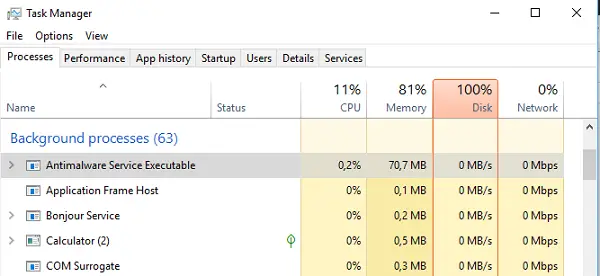
The best way to cross-check is to right-click on the program name, when in Task Manager, and open its file location. You will notice that it’s available under C:\ProgramData\Microsoft\Windows Defender\Platform\4.16.17656.18052-0. You can also invoke the Defender program manually to perform the scan, and this will increase the CPU and Memory usage.
Antimalware Service Executable High CPU, Memory, Disk usage
I have seen this program sitting in the background, and doing nothing. At times, I have seen it consuming 30% CPU usage. If you have seen it taking a high CPU portion, the chances are that it is scanning your files in the background. This is to make sure of a potential virus or malware.
You will notice these types of surges happen at certain events. When your PC boots, software installation is in progress, when you download the file from the internet or check your emails in Outlook with attachments.
The best part of this Antimalware Service Executable or Windows Defender is that it only does background scans when your PC is sitting idle. This makes sure that your PC is not slow when you are working, and running scans in the idle stage gives the program advantage of using more CPU resources.
MSMPENG.exe taking too much CPU, Memory power
If you’re faced with this high CPU, Disk, or Memory usage issue, you can try our recommended solutions below in no particular order and see if that helps to resolve the high CPU usage issue.
- Disable Cloud-delivered protection
- Check for malware infections
- Change Windows Defender scheduling options
- Add Antimalware Service Executable to Windows Defender’s exclusion list
- Run System File Checker
- Disable Windows Defender (not recommended)
Let’s take a look at the description of the process involved concerning each of the listed solutions.
1] Disable Cloud-delivered protection
- Open Windows Security
- Select Virus and threat protection
- Scroll down to Virus and threat protection settings
- Click on Manage settings button
- Here Turn off Cloud-delivered protection and Automatic sample submission.
- This should make a difference. If not, then read on.
2] Check for malware infections
It’s possible that your PC has a case of malware infection which is causing Windows Defender to disrupt your computer’s performance. In this case, run a full system scan using any standalone on-demand AV scanners. You may want to run Windows Defender Offline Scan at boot time or use bootable AntiVirus Rescue Media to invasively clean your system.
3] Change Windows Defender scheduling options
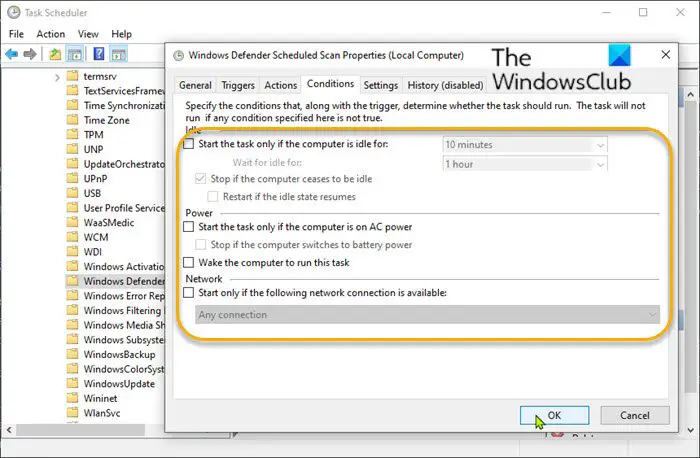
In some cases, the high memory usage caused by Antimalware Service Executable typically happens when Windows Defender is running a full scan. You can configure this scan that is run as a scheduled task, to take place at a time when you’re less likely to feel the drain on your CPU.
Do the following:
- Press Windows key + R to invoke the Run dialog.
- In the Run dialog, type
taskschd.mscand hit Enter to open Task Scheduler. - On the left pane, navigate to the path below:
Task Scheduler Library > Microsoft > Windows > Windows Defender
- Now, in the middle pane, double-click the Windows Defender Scheduled Scan entry.
- On the General tab, uncheck Run with highest privileges option.
- Next, click the Conditions tab and uncheck all the items in the section.
- Click OK to clear your scheduled scans.
To protect your computer, it is important to schedule/create some new scans, but we can do this in a way that will reduce the impact on your system’s performance.
Do the following:
- Double-click Windows Defender Scheduled Scan entry.
- Select the Triggers tab.
- Click the New button.
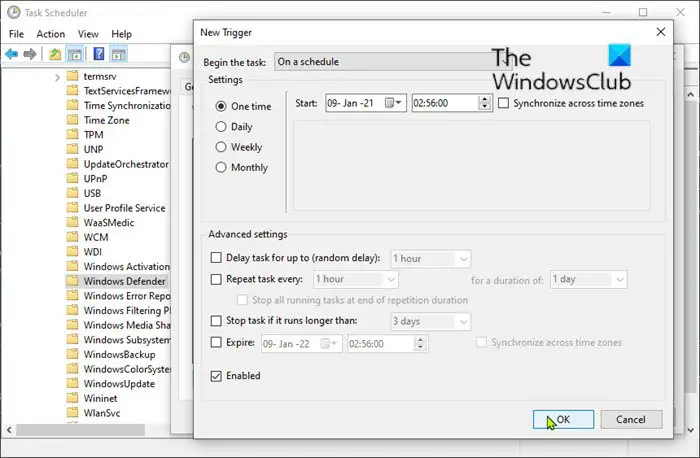
You can now create a new scan schedule that suits your needs – selecting options that strike the balance between protection and system efficiency. As a guideline, we recommend (at minimum) weekly scans at a time when you’ll be unlikely to notice the increased CPU usage.
- Click OK when done.
- Repeat the process for the three remaining services (Windows Defender Cache Maintenance, Windows Defender Cleanup, Windows Defender Verification) in the middle pane.
If the issue still persists after you have tried this solution, proceed with the next.
4] Add Antimalware Service Executable to Windows Defender exclusion list
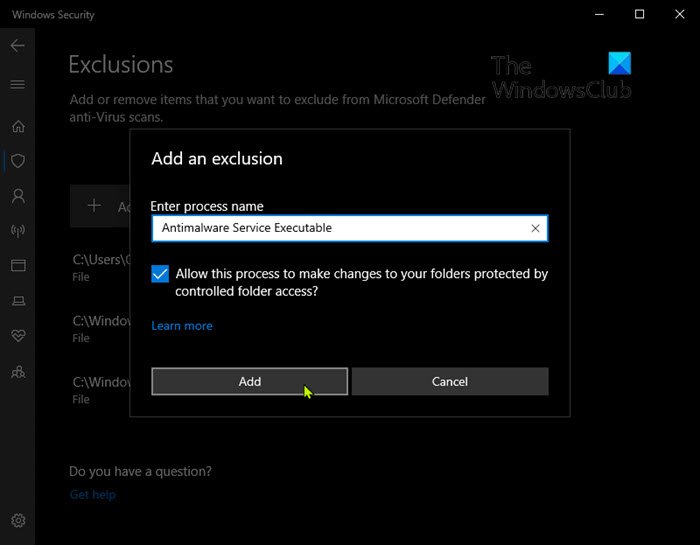
During its scans, Windows Defender checks every single file on your computer – including itself. This can occasionally result in system lag. In this case, you can add Antimalware Service Executable to Windows Defender exclusion list. Here’s how:
- Press Windows key + R to invoke the Run dialog box.
- In the Run dialog box, type
windowsdefender:and hit Enter to open Windows Security Center. - Click Virus & threat protection settings on the Navigation menu on the left.
- In the Virus & threat protection settings page, scroll down to the Exclusions section.
- Click the Add or remove exclusions link.
- In the Exclusions page, click the + Add an exclusion button.
- Select Process from the menu.
- In the Enter process name field, type Antimalware Service Executable.
- Click the Add button.
Read: How to disable Antimalware Service Executable in Windows
5] Run System File Checker
Running System File Checker may help replace potentially corrupted Defender files.
Related: Fix COM Surrogate high CPU or Disk usage.
6] Disable Windows Defender (not recommended)
As a last resort, if none of the above solutions yielded any positive result, you can disable Windows Defender altogether. Keep in mind that doing so leaves you vulnerable to a range of cyberattacks, so it’s critical that you install a reputable and lightweight third-party security software on your Windows 10 computer before disabling Windows Defender.
Is it safe to disable Antimalware Service Executable?
We do not recommend that all, as mentioned above. The biggest reason that goes into our support is that it works along with a third-party antivirus solution. It runs as a background process and offers your system a solid layer of protection. While scanning files it can detect a malicious file and immediately inform you about it. This gives you enough reason not to disable Windows Defender.
Windows Defender disables it automatically when you install a third-party antivirus.
There are many more reasons. Windows Defender is the last protection you have got when it comes to ransomware which can lock down your files. Microsoft has implemented this feature with OneDrive to make sure your files are safe and can be recovered back.
How do I stop antimalware service executable from using high memory, CPU, Disk Usage?
However, if you feel like it’s taking too much resources, you can turn off the real-time protection.
Go to Settings > Update & Security > Virus & threat protection > Virus & threat protection settings and disable Real-time protection. It will automatically enable it when it doesn’t find any AntiVirus software installed on your PC.
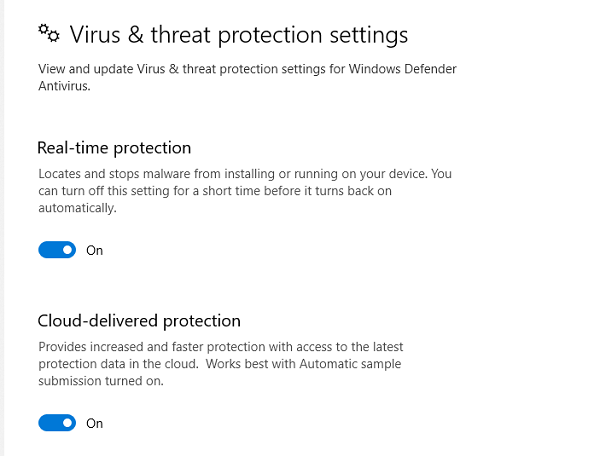
As I said, Windows Defender works along with other antivirus solutions. Even though it disables itself, from time to time, it will scan your PC. It will figure out risks that could have been missed by your primary antivirus solution.
I hope this explains what the Antimalware Service Executable is.
Read next: Services and Controller app High CPU usage.
“We do not recommend that all. The biggest reason that goes in our support is that it works along with third-party antivirus solution. This gives you enough reason not to disable Windows Defender. Windows Defender disables it automatically when you install a third-party antivirus.”
This is in your article. I must say that Windows Defender seems to “Enable” itself frequently, after a Windows 10 Update. I have had to “Disable” Windows Defender because it does not “play nicely” with Bitdefender Total Security 2018 and Bitdefender does not always “Disable” Windows Defender. I have been getting strange notices, since this last attempt to Update. I have to go into Security and fix Windows Defender, twice now. This has to be part of the reason for the Failed Update times 4.
Just saying this has been my experience for the past week or so. This also very easily could be unique unto me, only. }:O)
We have 4 computers so far that start running very slow due to windows defender using up 30+ % of the CPU…. the process never ends. Reboot few times, it kept coming back.
In one computer I was able to fix by running disk /online …. but on the other 3 I had to do a windows reset.
I can’t tell what is causing it…my guess is the windows update, currupted files or applications.
Any suggestions?
i had similar problem. i had read that it easy for the windows antivirus to get infected. after i have seen an online solution to add the antimalware itself into its own exclusions, i have come to idea that it is infected itself. so, then i have reinstalled windows.
warning: you will need to reinstall all programs if you reinstall windows!
warning: if you connect your hdd to other computer not with usb cable, but directly, i am afraid you may boot from it and infect the healthy hdd, so you sould carefully choose boot device. also you should be afraid of running programs from the infected hdd manually or by some autostart mechanism, though as far as i know that autostart was in windows xp, but it is not very actual with more new versions of windows, since it is disabled by default.
warning: you may lose your windows’ activation! i think my windows key was saved in efi partition, you may need to find and write your windows product key to a paper.
for that (reinstalling windows), i have connected its hdd via external case with usb cable to a linux, and deleted windows and program files (except some configuraion files of programs in appdata), (also i deleted users directory and others, moving my files to another folder before that), (just deleting whole c: partition, moving your files to other place before that, may be faster, if you have files of little total size), and deleted some partitions, except EFI boot partition, though that was dangerous, i hoped it (the EFI partition) was not infected. then, i created new windows 10 iso and dvd and reinstalled windows using it.
about not deleting efi partition: i thought my windows key was saved in it. i think i could get windows product key using some command or program from inside the old infected windows, i am not sure whether i could get windows key from that partition by other method. i think i could, if i had windows key, alternatively change gpt partition scheme to mbr and delete it (the EFI). i had seen that windows did not install due to GPT if i put laptop to non-EFI mode. or, if i was sure i can get windows key from the efi later, i could remove boot flag from it instead of deleting it.
alternatively, instead of reinstalling windows, you can try to check your windows hdd with other antivirus, installing it to same system, or, better, to other machine, and connecting this infected hdd to it, and booting from the healthy hdd.
why i did not just run windows installer from inside the old infected windows installation? because it was recommended to me to format all hdd and to boot from the installer dvd in order to not infect fresh installation. i believe in this principle, and, as i said, i just delete some files instead of deleting/formatting all partitions, because formatting would require a new hdd to move files to it.
alternatively, you can try to get old state of your system from some backup system… (there are also windows’ built-in system or systems, and you may have one from laptop manufacturer and you may have made backups manually or get them automatically). (this may delete your latest changes to your files, so you may need to save such files somewhere).
alternatively, you can reinstall windows from laptop manufacturers’ special partition. i have not used this way, because windows 8 was there, and i wanted to try to install a “vanilla” windows, ie without the additional preinstalled soft.